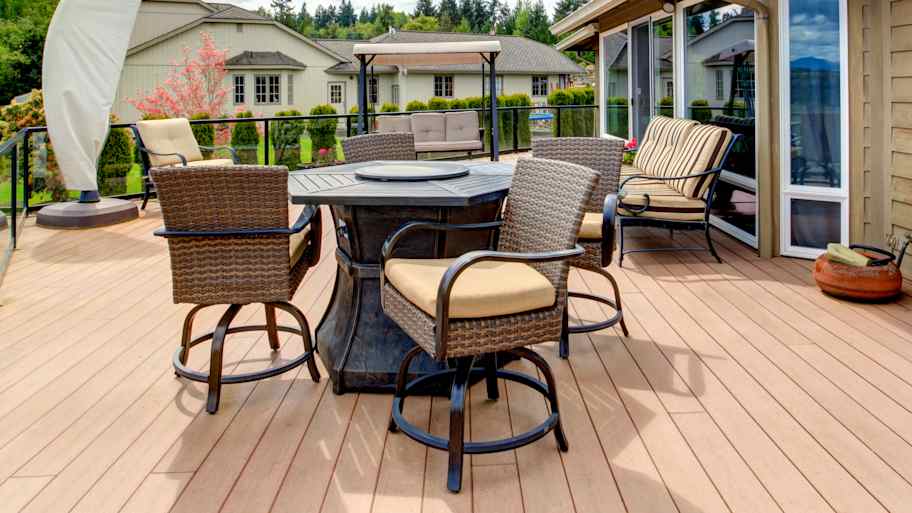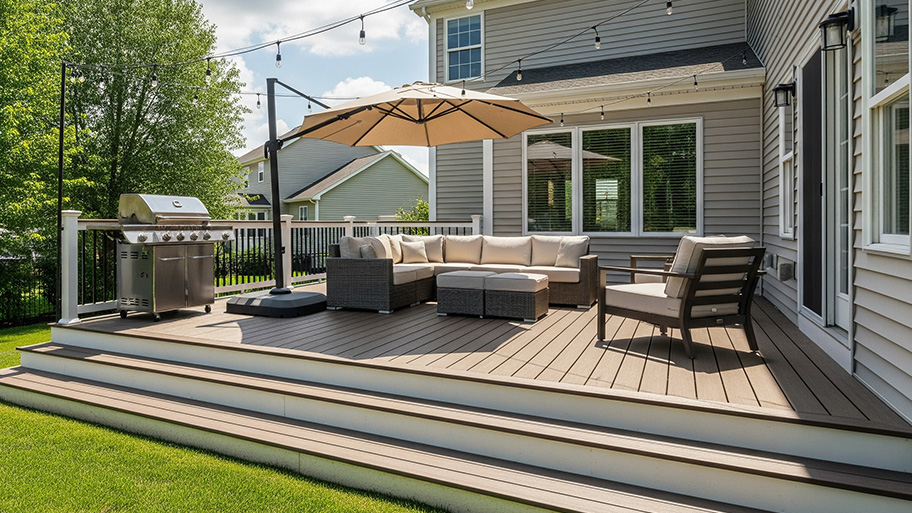
If you’re updating a deck or staircase with a modern railing, you may be wondering how much cable railing costs. We dive into the cost factors you need to know.
Mahogany decking costs between $5,900 and $18,400, with most homeowners paying an average of $14,250. Your price depends on deck size, mahogany type, and labor rates.


Mahogany decking offers durability and a premium look.
Deck size, labor, and wood grade are key mahogany decking cost drivers.
Expect to pay $25 to $70 per square foot including materials and labor.
Installing a mahogany deck offers an ROI of 60% to 75%.
Professional installation costs $15 to $35 per square foot and ensures safety and long-term performance.
This article was created using automation technology and thoroughly fact-checked and edited by an Angi Editor in accordance with our AI policy.
On average, mahogany decking costs $14,250, with most homeowners spending between $5,900 and $18,400. Expect to pay $25 to $70 per square foot installed, depending on mahogany type, deck size, and labor rates. Understanding these costs helps you plan your project and avoid surprises.
Mahogany’s natural beauty and strength make it a favorite for outdoor living spaces. Knowing what impacts your total investment ensures your deck project meets both your budget and long-term needs.
The size of your mahogany deck is the single biggest factor in the total project cost. A larger deck requires more materials and labor, driving up the price. Small decks (120 to 200 square feet) cost less overall but have a higher cost per square foot due to minimum labor fees. Medium decks (200 to 400 square feet) are most common and can offer the best value per square foot. Large or custom-shaped decks, including multi-level designs, require more structural support and extra labor, raising costs further.
Contractors often have project minimums—around 120 to 150 square feet—so even small decks may reach a baseline price. Custom features, curves, or multi-level layouts can increase both material waste and labor hours, impacting your final bill.
| Deck Size (Sq. Ft.) | Average Cost |
|---|---|
| 120 | $3,000–$8,400 |
| 300 | $7,500–$21,000 |
| 500 | $12,500–$35,000 |
The type of mahogany you choose has a major impact on both cost and performance. Genuine mahogany (often called Honduran or South American mahogany) is prized for its rich color and durability, but it is more expensive and less readily available. Philippine mahogany, which includes Red Balau, Batu, and Meranti, is more budget-friendly but varies in resistance to weather and pests.
Solid mahogany boards cost more than engineered or composite mahogany options, but they offer classic appeal. Sourcing also matters: FSC-certified and imported mahogany may carry a premium, while domestic options can be less expensive but may not offer the same look or longevity. Board sizes also affect cost, with wider or thicker boards increasing material expenses.
| Mahogany Type | Description | Cost per Sq. Ft. | Pros | Cons |
|---|---|---|---|---|
| Genuine mahogany | South/Central American, premium durability | $35–$70 | Long-lasting, beautiful grain | Costly, limited availability |
| Philippine mahogany | Includes Red Balau, Batu, Meranti | $25–$45 | Affordable, decent durability | Not as strong, color variation |
| Engineered/composite | Blended with resins, mimics mahogany look | $20–$50 | Lower maintenance, stable | Less authentic appearance |
| FSC-certified | Sustainably sourced, eco-friendly | $30–$65 | Environmentally responsible | Higher cost, may be special order |
Where you live affects your total mahogany deck cost. Labor rates are higher in cities and coastal regions, while rural areas may see lower prices but less contractor availability. Material costs also fluctuate based on how far mahogany needs to be shipped, with regions far from ports or major distribution centers seeing higher delivery fees.
Urban areas often have stricter permit requirements, increasing the total cost. Climate can play a role too—humid or rainy regions may require higher-grade mahogany or more frequent maintenance, impacting your long-term investment.
Several key factors shape the total price of your mahogany decking project. Let’s break them down so you know where your money goes.
Most mahogany decks are installed by deck contractors or skilled carpenters. Labor rates range from $15 to $35 per square foot, or $50 to $150 per hour, depending on the region and the pro’s experience.
There are often minimum labor fees for small projects, and complex designs or premium mahogany types can push labor costs higher. Specialized installers may charge more but often deliver superior fit and finish.
You’ll need a permit for most new deck installations or major upgrades. Permit fees range from $100 to $500 depending on the municipality. Some areas require multiple inspections, which can add $50 to $200 per visit. Permits are essential for passing code and ensuring safety, and their cost should be part of your budget.
Adding features like deck railings, stairs, benches, or lighting increases your total cost. Deck railings add $40 to $200 per linear foot, while built-in benches or planters can cost $500 to $2,500 each.
Upgrades such as hidden fasteners, decorative inlays, or custom borders can add $3 to $10 per square foot. Skirting, privacy screens, pergolas, and accessibility features like ramps also raise costs, particularly for custom or premium finishes.
Project complexity is a significant driver—multi-level decks, curves, or unusual shapes take more time and expertise. Site accessibility can influence labor if your yard is hard to reach or slopes steeply. Preparing the site, including excavation or removing old decking, may add $500 to $3,000.
Delivery fees for mahogany range from $100 to $800, especially for remote locations. Don’t forget design or architectural fees for custom plans, which can add $1,000 to $2,000, and post-construction cleanup, costing $200 to $600.
Beyond installation, there are ongoing and sometimes unexpected costs to keep in mind.
Many mahogany decking materials come with a limited manufacturer warranty, often covering defects for 10 to 25 years. Workmanship warranties from contractors can last one to five years. Extended warranties may be available for an added $200 to $1,000. Always check what’s included—most exclude normal wear, weathering, or improper maintenance.
You’ll need cleaning supplies and sealing products to maintain your deck, costing $50 to $200 per year. If you add lighting or electrical features, expect a small increase in your utility bill, often less than $10 per month.
Mahogany decking needs annual cleaning and sealing to look its best and resist the elements. Professional maintenance costs $400 to $1,500 per year, depending on deck size and service level.
DIY maintenance costs less, but requires time, tools, and know-how. Regular upkeep can extend your deck’s lifespan to 20 to 40 years. Minor repairs, like replacing a board or tightening fasteners, cost $100 to $500.
Sales tax on materials can add 5% to 10% to your material bill, depending on your state. Some areas assess local taxes or permit fees for home improvements, so check with your local building department.
A new deck may increase your homeowners’ insurance premiums by $20 to $100 per year. If your deck is large or includes expensive features, you may need to increase your coverage to protect your investment. Always notify your insurer after adding a major structure to your property.
Building your own mahogany deck can save on labor, but it comes with challenges. DIYers avoid labor charges, which cost $15 to $35 per square foot, but they risk higher material waste from mistakes. You’ll need tools like saws, drills, levels, and safety gear—renting or buying these can add $500 to $2,000 to your cost.
A 300-square-foot DIY mahogany deck might cost $7,500 to $10,500 in materials and supplies, but require 40 to 100 hours of work. Professional installation, while more expensive, ensures code compliance, quality, and warranty protection. DIY is best for those with advanced carpentry skills and time to spare; otherwise, hiring a pro provides peace of mind and lasting results.
Compare the costs of DIY vs. a professionally installed 300-square-foot deck:
DIY: $6,500 to $10,500 (materials, supplies, no labor), plus your own time.
Pro-installed: $7,500 to $21,000 (materials and labor included), with faster completion and warranty.
Deciding whether to repair or replace your mahogany deck depends on age, damage, and cost. Repair is suitable for minor issues like loose boards, small areas of rot, or surface splintering. Deck repairs cost $100 to $1,000, depending on the extent.
If your deck has widespread rot, structural problems, or is nearing the end of its lifespan (20 to 40 years), replacement is the smarter investment. A full replacement of a 300-square-foot deck costs $7,500 to $21,000. If repair costs approach 50% of replacement (the “50% rule”), it’s time to consider a new deck. Always check your warranty and deck age before making a decision.
Installing a mahogany deck provides a return on investment (ROI) of 60% to 75%, depending on your region and home value. A new deck can boost curb appeal and increase resale value, especially in markets where outdoor living is prized.
Compared to composite or pressure-treated decks, mahogany offers a classic look and natural durability, often fetching a higher price from buyers. ROI is highest when the deck is well-designed, well-maintained, and complements your home’s style. Added benefits include improved safety, expanded outdoor living space, and enhanced aesthetics. Universal design features, such as ramps or wide stairs, can further broaden your home’s appeal.
Consider these cost-saving strategies to make your mahogany deck project more budget-friendly:
Choose budget-friendly mahogany alternatives or lower grades to save on materials.
Build during the off-season when contractors may offer lower labor rates.
Get multiple quotes from qualified local deck builders to compare pricing and services.
Limit custom features or complex shapes to reduce material waste and labor.
Handle demolition, site prep, or finishing work yourself if you have the skills.
Purchase materials in bulk or during seasonal sales for better pricing.
Maintain your deck regularly to avoid expensive repairs or premature replacement.
Home is the most important place on earth, which is why Angi has helped more than 150 million homeowners transform their houses into homes they adore. To help homeowners with their next project, Angi provides readers with the most accurate cost data and upholds strict editorial standards. We extensively research project costs to develop the pricing data you see, so you can make the best decisions for you and your home. We rely on reputable sources, including the U.S. Bureau of Labor Statistics, academic journals, market studies, and interviews with industry experts—all to ensure our prices reflect real-world projects.
Want to help us improve our cost data? Send us a recent project quote to [email protected]. Quotes and personal information will not be shared publicly.
From average costs to expert advice, get all the answers you need to get your job done.

If you’re updating a deck or staircase with a modern railing, you may be wondering how much cable railing costs. We dive into the cost factors you need to know.

Refinishing your deck is a great way to restore its appearance and fall in love with your outdoor space. Use this guide to learn how much it costs based on factors like size and type.
Deck repair costs depend on materials, damage you need to fix, and more. See how much it costs to replace or repair a deck in Columbus, OH.

Decks provide usable outdoor space for relaxing and entertaining. But do decks add value to a home? Find out the answer in this informative guide.

Don’t let deck stain problems steal the spotlight from your outdoor space. Here is how to fix these issues before your next backyard party.

You might know about deck boards and railings, but what are the other parts of a deck? Here are the parts you should know before you build a new deck.